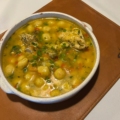Ketchup, deemed by many as the most infamous of all condiments (a rather unfair statement) has in fact a pretty noble history. The red, savory and sweet concoction we keep in our fridges nowadays (“he who is without ketchup, let him cast the first stone”) is in fact the final product of a long history of trading and colonialism. One could even say it was born in the crossroads of several different caminos, especially if we consider that most pilgrimage routes are in fact ancient trading routes, repurposed.
Ketchup is the direct descendent of at least two funky, fishy, ancient sauces that were sold and traded along some of these trails. One of the two ancestors of ketchup is (more accurately, was) the Chinese kē-tsiap –the sauce that gave ketchup its name. Kē-tsiap was a thick sauce made basically of fermented, preserved fish. The British imported the first samples and then reproduced it at home. However, the original recipe did not include tomatoes: let us not forget tomatoes didn’t arrive in Europe until the 16th century. It was mainly made from mushrooms, anchovies, and oysters.
However, this was not the first fishy “ketchup” in Europe. Enter the Roman garum, the other ketchup forefather.
If you are into funky fish flavors, you are going to love garum. Garum was the literally omnipresent ingredient of any dish in a Roman banquet. In fact, one can find references to it in classic Roman literature of the 4th and 5th centuries. In Pompeii, we find the remains of an actual garum factory. Made from fermented fish guts and salt, close to a regular anchovy paste, garum was found in almost every Roman recipe either on its own, as a flavor enhancer, or combined with other ingredients: one could easily have vinegar with garum (oxygarum), peppered garum (garum piperatum), or even “garumed” wine and water (oenogarum and hydrogarum, respectively). That is, garum was used either on its own, or as a base sauce which would later be combined with other ingredients: honey, herbs, wine.
According to the Italian archeologist Claudio Giardino, from the University of Salento, the economy of garum was exactly like that of wine: a good bottle of premium garum would cost you a pretty penny, whereas the Roman populace would have no problem finding cheaper, less exquisite varieties.
But has garum entirely disappeared from Mediterranean cuisine since Roman times? The answer is yes, and no: you might want to add some Southwestern Italian colatura di alici to your next homemade pasta dish for a glimpse into ancient Roman food –hint: it’s even better if you add some capers on top.





